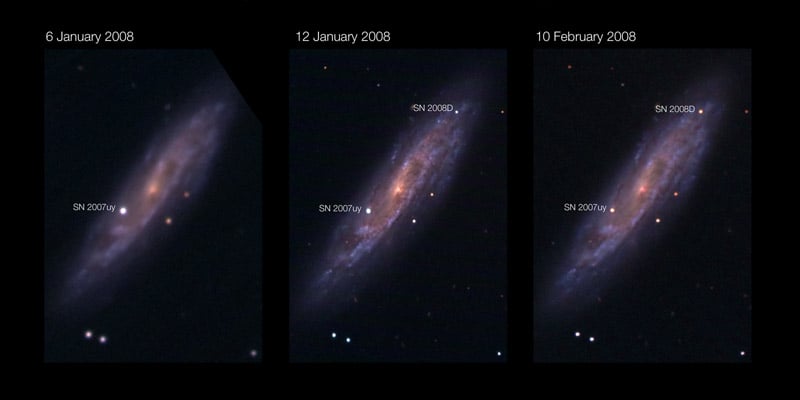[/caption] Just when we thought we were beginning to understand what supernovae and gamma ray bursts were all about. Astronomers have just uncovered the true nature of what they thought was a regular supernova observed in January. At the time, it looked like a supernova emitting a 5-minute long burst of X-rays. But these X-rays were of a lower energy (known as "soft" X-rays) than expected leading some to believe this was a normal emission from a supernova explosion that was being observed
during
detonation (astronomers don't usually get the chance to observe a star as it explodes and usually have to make do with analysing the supernova remnant). However, it is now believed this strange supernova event may have been emissions from a dying star at an intermediate mass, neither producing a supernova nor a gamma ray burst, but a combination of both...
Orbiting above Earth on January 9th 2008, the NASA/STFC/ASI Swift telescope caught a rare glimpse of what seemed to be a "normal" supernova at the precise moment of detonation. This observation was completely by luck, as Swift was already observing a supernova remnant (SN 2007uy) in spiral galaxy NGC 2770 that had exploded the previous year (90 million light-years away near the Lynx constellation). Then, as Swift was retrieving data from the SN 2007uy remnant, SN 2008D blasted a 5-minute long burst of X-rays in the same galaxy making this the first supernova to be directly observed.
However, looks can be deceiving. Researchers from a host of institutions including Italian National Institute for Astrophysics (INAF), the Max-Planck Institute for Astrophysics (MPA) and the European Southern Observatory (ESO) have analysed the supernova data thoroughly and at first agreed with the original assessment that it was indeed "normal."
" ." - Paolo Mazzali, INAF's Padova Observatory/MPA, research leader.
[caption id="attachment_16000" align="alignleft" width="184" caption="Artist impression of the twin jets from a GRB. Credit: Dana Berry/SkyWorks Digital"]
[/caption]
However, astronomers at the Asiago Observatory in Northern Italy had designated the event as a Type 1c supernova, more commonly associated with long-period gamma-ray bursts. Type 1c supernovae are generated by hydrogen-poor progenitor stars with helium-rich outer layers prior to exploding at the end of their lives. But SN 2008D generated soft X-rays more associated with smaller stellar explosions. Therefore SN 2008D was probably produced by a star that was massive at birth (approximately 30 solar masses), rapidly using up its hydrogen fuel in its short life until it was only 8-10 solar masses. At this point it exploded, probably creating a remnant black hole. This chain of thought has led Paolo Mazzali and his team to think SN 2008D was produced by an object of a mass at the boundary of a normal supernova and gamma-ray burst.
" [X-ray] ." - Massimo Della Valle, co-investigator.
Researcher and co-author Stefano Valenti points out that this discovery indicates that all black hole-producing supernovae have the potential to be gamma-ray burst progenitors. "
The scenario we propose implies that gamma-ray burst-like inner engine activity exists in all supernovae that form a black hole
," he added.
Source:
ESO
 Universe Today
Universe Today
